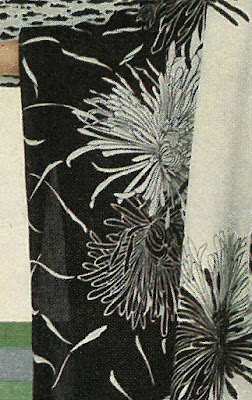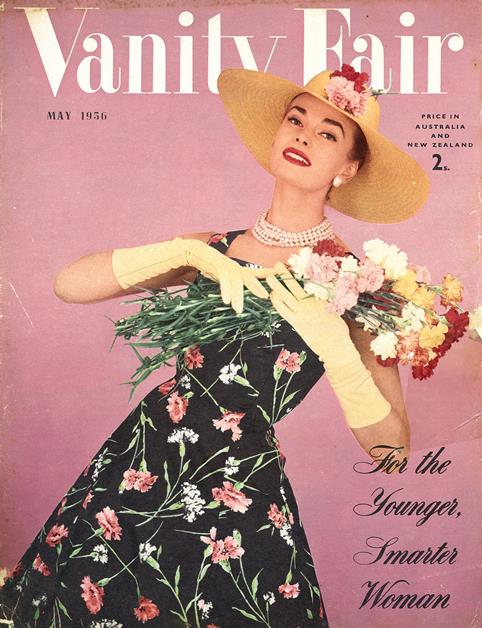In the 1960s fashion started to fracture. To begin with, there was a generational split as the young decided that they did not want to dress like their parents. There was an avant garde of designers who were very avant, and a more conservative mass market that struggled to keep up—or didn't bother trying. In London dozens of boutiques sprang up catering to trendy teens and twenty-somethings, while in Paris the traditional couture struggled with an older and shrinking client-base. Meanwhile people in more conservative places looked on in bewilderment as hemlines went up and up...
It must have been wonderful for people who suddenly had room to express themselves in their clothing, but it does cause problems for a fashion history buff looking for pictures representing each year's style trends!
However the first years of the 1960s were basically just an extension of the 1950s.
 |
Beyer Mode, April 1960
|
For 1960 I present this dress on the cover of Beyer Mode: a fairly standard shirtwaister in a large houndstooth check, with large buttons (a popular early-sixties touch) and wide collar. Since the photo isn't full length it's impossible to see how long the skirt is—but the fashionable length in 1960 was just skimming the bottom of the knee-cap.
 |
Australian Home Journal, October 1961
|
The three frocks depicted on the cover of
Australian Home Journal roughly sum up the fashionable state of play in 1961. On the left is dress with a slim skirt designed for a mature woman, decorated by a large collar ending in a bow. In the centre, a dress intended for a younger woman in an abstract print. It is ornamented by sleeves in broderie anglaise, huge patch pockets and large buttons. On the right a dress for a young teen in stripes, decorated with bows and applique.
 |
La Pastorale, Spring and Summer 1962
|
By 1962 we're starting to see an even split between slim and wide skirts. Both styles are belted in at the natural waistline, and the look is still very feminine and ladylike. The model second from the left is wearing a fashionable modernist print.
 |
Australian Home Journal, February 1963
|
By 1963 the slim skirt is becoming a shift: the model on the left is wearing an unbelted dress with the waist dropped to the top of the hips. The model at the centre front is wearing a more traditional shirt waist dress with a belt and a wide pleated skirt.
 |
David Jones, Spring and Summer 1964
|
David Jones sold these two easy-but-elegant shift dresses on the cover of its 1962 Spring and Summer catalogue. Both dresses were made in knitted Estacel (an acetate fibre). Knitted fabrics would come to play a big role in the fashions of the 1970s.
 |
La Pastorale, Spring and Summer 1965
|
I chose this photograph for two reasons: firstly because the dresses here are made in "Arnel" (a trademarked polyester) and secondly because they are described in the catalogue as "Chelsea Look". This meant that "La Pastorale" was trying to imitate the looks coming out of the boutiques of "Swinging London". As you can see it was not entirely successful. The line is more or less right, as are the little-girl touches like frills around the neckline and sleeves. However, by 1965 the hemline had risen well above the knees in fashion-forward London and Paris. Yes, the miniskirt had been launched, though other parts of the world were slower to adopt it.
In Melbourne (where "La Pastorale" was located) the miniskirt made its rather
scandalous debut around the time this catalogue was printed...
 |
| Montgomery Ward, Spring-Summer 1966 |
These dresses from Montgomery Ward are for
juniors, not adults, but by 1966 all the trendiest clothes are being made for teenagers. Curves were decidedly out, and skinny adolescent figures were
in. These garments are described as being "inspired by Paris", and the dress in the centre looks like a knockoff of a
coat-dress by Courregѐs that appeared in his 1965 collection. Let's hope it was a licensed knockoff!
There is also a copy of Saint Laurent's "Mondrian" dress in the same catalogue.
 |
| Winns Spring and Summer Catalogue, 1967 |
A skimmer and a shift dress. These two outfits exemplify the late sixties look: youthful (almost childlike), short, cut along simple lines, brightly coloured and with geometrical decoration.
 |
| Burda Moden, April 1968 |
The childlike, almost childish, look continues in 1968. These dresses from
Burda Moden could almost be children's dresses—except for the sizing, of course! Short and unfitted with little flippy skirts, they conceal the wearers' adult bodies. Even the accessories play into the juvenile theme. The models are wearing almost flat shoes with straps across the instep like a little girl's party shoes.
 |
| National Bellas Hess Spring Sale, 1969 |
And in a 1969 catalogue, a range of mainstream fashions from the end of the decade. The dresses are still short and either hang straight from the shoulders, shift style, or have a dropped waist seam. Though they give off a youthful energy, the fact that they are advertised in "Half Sizes" indicates that women with more mature figures sometimes wore them.
The counterculture was making inroads on the high fashion scene, but was as yet to impinge on mass-produced styles. However, the model at the lower left is wearing a paisley print, a pattern made popular by the hippies.
The early seventies would see the summer dress eclipsed for the first time in decades as separates came into favour and pants became more acceptable for everyday wear. But that, as they say, is another story...


















































